Day 2, Sessions, Tuesday 27 October
Day Two Explores International Perspectives and Council Research Efforts

The momentum of day one continued in full force throughout day two, this time with a number of sessions focused on tall building projects outside of the American region. From the Kingdom Tower in Jeddah, Saudi Arabia to The Shard in London, United Kingdom – and from the MahaNakhon Tower in Bangkok, Thailand to Australia 108 in Melbourne, Australia – the day presented insights into nearly every corner of the globe. The international efforts of the Council were also put on display, as a number of CTBUH research undertakings were presented in various stages of completion.
Plenary Two – Global Icons for a New Era of Tall
There couldn’t have been a better way to start Plenary Two, and the second day of the Conference, than with a keynote presentation on the world’s future tallest building, the Kingdom Tower at 1000+ meters. Here, His Excellency Abdulrahman Al Shaikh (Deputy Minister for Town Planning, Ministry of Municipalities & Rural Affairs, Kingdom of Saudi Arabia) and Mounib Hammoud (CTBUH Trustee and CEO, Jeddah Economic Company) framed the kilometer-high mixed-use tower in the context of Saudi Arabia’s emerging economic presence. Not designed in isolation, Kingdom Tower will become the focal point of an entirely new urban district, Kingdom City, which will have a built-up area of 12,280,945 square meters and include a full range of land uses and amenities set within a network of modern infrastructure.

Next, Irvine Sellar, Founder and Chairman of Sellar Properties, took the stage to discuss the past, present, and future of London’s tallest and most iconic building, The Shard. Since completing in 2013, the tower has redefined the London skyline and has played a key part in the regeneration of London’s South Bank. Sellar said, “It’s been 14 years in the making, and I believe what we’ve created with The Shard is a work of art, a new contour for London’s skyline. It hasn’t been an easy journey, in fact, it’s been realized against all odds. Developments of this nature in the UK are never straight forward, and in London it’s many times more complicated.”
The Asia region was also well represented in the Plenary, as Sorapoj Techakraisri (CEO, PACE Development Corporation PLC) presented the MahaNakhon, a tower in Bangkok, Thailand that will not only be the nation’s tallest, but is intended to forever elevate the image of the city and the country to a global audience. Techakraisri offered three aspects of the project that were critical in achieving this goal: an ideal location in Bangkok’s central business district, mixed programming, and a unique design approach.
Discussions on International Development Put Forward
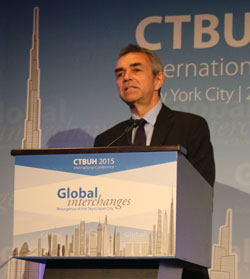 If the themes covered throughout the day proved anything, it’s that the skyscraper resurgence occurring around the world is as diffuse as it is compelling. Following some of the thoughts shared earlier by Irvine Sellar, David Partridge (Managing Partner, Argent) reinforced the importance of transportation connectivity in generating robust activity in London. During Session 4c, Partridge presented the master plan for King’s Cross, the most connected transportation hub in the city for both national and international travel, an attribute that will help drive the development of 22 office buildings, 17 residential buildings, 500,000 square feet of retail, and a number of cultural, leisure, and education amenities.
If the themes covered throughout the day proved anything, it’s that the skyscraper resurgence occurring around the world is as diffuse as it is compelling. Following some of the thoughts shared earlier by Irvine Sellar, David Partridge (Managing Partner, Argent) reinforced the importance of transportation connectivity in generating robust activity in London. During Session 4c, Partridge presented the master plan for King’s Cross, the most connected transportation hub in the city for both national and international travel, an attribute that will help drive the development of 22 office buildings, 17 residential buildings, 500,000 square feet of retail, and a number of cultural, leisure, and education amenities.
Meanwhile in Session 4a, Daniel Libeskind took the audience on a trip from New York, through Milan, and finally to Busan. In each city, Libeskind highlighted how local identities of place were used to drive sincere and unique human experiences in various high-rise complexes. He outlined how these considerations, in addition to new understandings of public space and what it truly means to be a sustainable community, were at the heart of plans for the World Trade Center in New York, the Haeundae Udong Hyundai L’Park in Busan, and the CityLife development in Milan. At the end of his presentation, Libeskind concluded, “Architecture is not just technology and density and infrastructure and typology – it’s a civic art, it has always been a civic art. People forget the ‘art’ part; they think its some goofy thing for some star architects, but no, without civic art cities die and people lose interest in them.”
The social lens of design was also addressed by Hiroo Mori, Executive Vice President, Mori Building. Mori chronicled the history of the Japan-based development firm, calling attention to its signature “Vertical Garden City” approach to urban development, which prioritizes the co-location of high-rise office and residential, public green space, transportation systems, and cultural facilities. Mori Building has implemented this concept in numerous locations throughout Japan and abroad since the 1980s, most recently at Toranomon Hills (2014) in Tokyo. “Mori Building uses three major themes [throughout their projects]: safety and security, greenery and the environment, and art and culture. The vertical garden city model makes these three themes possible,” Mori asserted.
Sessions Come Full Circle, Back to New York
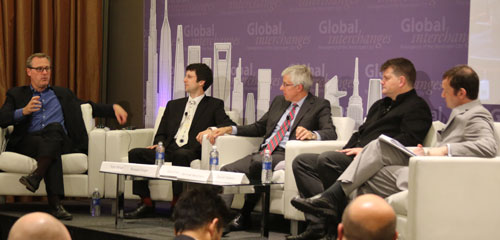 Talk of place then shifted back to the conference location of New York in Session 5e, New York 2050. This session, chaired by CTBUH China Office Director Daniel Safarik, took an appropriate look toward the future of America’s foremost skyscraper city, featuring panelists Kai-Uwe Bergmann, Partner, Bjarke Ingels Group; Russell Unger, Executive Director, Urban Green Council; Scott Frank, Partner, JBB; and Tom Wright, President, Regional Plan Association. The wide range of specializations on stage provided a very diverse and rich dialogue, with topics ranging from that of collective climate change responses to market shifts and social balance.
Talk of place then shifted back to the conference location of New York in Session 5e, New York 2050. This session, chaired by CTBUH China Office Director Daniel Safarik, took an appropriate look toward the future of America’s foremost skyscraper city, featuring panelists Kai-Uwe Bergmann, Partner, Bjarke Ingels Group; Russell Unger, Executive Director, Urban Green Council; Scott Frank, Partner, JBB; and Tom Wright, President, Regional Plan Association. The wide range of specializations on stage provided a very diverse and rich dialogue, with topics ranging from that of collective climate change responses to market shifts and social balance.
An animated discussion took place when Safarik asked the panelists to impart what they believe the New York skyline will look like in 2050 in terms of shape, programming, social equity, and some of the amorphous concepts taking shape in the built environment. Tom Wright said, “There’s going to be a growing consensus for figuring out financial feedbacks loops that make sure that the people benefiting or investing enormous amounts of money into apartments in the sky are also supporting the services that they are benefiting from.” Bergmann built on Wright’s thought, adding, “Equity, I think, is actually achieved through public space… and the question I would have and would place out to the investors and the developers in the creation of these living working towers is ‘How do these public space get funded?’”
CTBUH Research Efforts Bearing Fruit
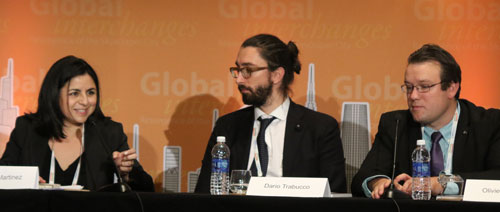 The second day of the Conference also put the research agenda of the CTBUH on display for all to see and enjoy in its various incarnations. During Plenary Two, the recipient of the latest CTBUH International Research Seed Funding was announced, Jason Barr an Economics Professor at Rutgers University. Barr will use the $20,000 award to investigate the determinants of skyscraper heights and completion rates across 62 Chinese cities from 1978 to 2014. Now in its fourth year, this year’s seed funding has been made possible with the kind support of Sun Hung Kai Properties Limited.
The second day of the Conference also put the research agenda of the CTBUH on display for all to see and enjoy in its various incarnations. During Plenary Two, the recipient of the latest CTBUH International Research Seed Funding was announced, Jason Barr an Economics Professor at Rutgers University. Barr will use the $20,000 award to investigate the determinants of skyscraper heights and completion rates across 62 Chinese cities from 1978 to 2014. Now in its fourth year, this year’s seed funding has been made possible with the kind support of Sun Hung Kai Properties Limited.
Later that day, the results of last year’s Seed Funding were presented in the form of facaderetrofit.org. This database, created by a team of faculty and students at the University of Southern California (USC), is an online resource for the AEC community, which hosts hundreds of building projects that have undergone or are in the process of a façade retrofit. Andrea Martinez from USC presented the database in its completion during Session 5d, encouraging all attending to help grow this promising asset.
The Council was also very proud on the occasion of the Conference to release the results of a three-year research endeavor called A Life Cycle Assessment of Tall Building Structural Systems. This project, sponsored by ArcelorMittal, quantifies for the first time the embodied energy and global warming potential of myriad structural systems and materials for tall buildings. The final research report publication went on sale at the CTBUH Exhibition Stand during the conference and a presentation was given on topic by the Council’s own Dario Trabucco, Research Manager, CTBUH.
Student Initiatives Shine on Plenary Stage
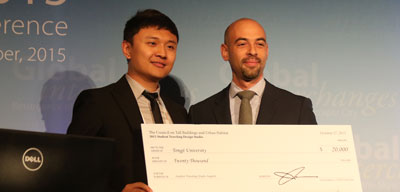 Several of the Council’s student initiatives also came into the spotlight, two of which were recognized on the main stage during the morning’s Plenary. First, Tianyi Geng and Tengi Li from the University of Nottingham were announced as the winners of the 4th CTBUH 2015 International Student Tall Building Design Competition, for their project “London Vertical Campus.” The competition began in August with 210 initial submissions, five of which were flown to the conference from around the world to present their projects to the esteemed jury, chaired by Moshe Safdie. The five winners were announced during the morning plenary and the first-place student took the stage to accept an additional check from the competition sponsor, China Construction America/Plaza Construction.
Several of the Council’s student initiatives also came into the spotlight, two of which were recognized on the main stage during the morning’s Plenary. First, Tianyi Geng and Tengi Li from the University of Nottingham were announced as the winners of the 4th CTBUH 2015 International Student Tall Building Design Competition, for their project “London Vertical Campus.” The competition began in August with 210 initial submissions, five of which were flown to the conference from around the world to present their projects to the esteemed jury, chaired by Moshe Safdie. The five winners were announced during the morning plenary and the first-place student took the stage to accept an additional check from the competition sponsor, China Construction America/Plaza Construction.
Next, a significant award was presented to the College of Tongji University at Shanghai for the 2015–2016 CTBUH Student Design Research Studio. This year, with assistance from the Council and funding from Arquitectonica, architecture students from Tongji University will analyze the Brickell City Centre development in Miami, proposing programmatic and design solutions for the Phase II Tower and its integration into the development’s existing Phase I buildings.
Council Officially Launches 100 Tallest Buildings Book
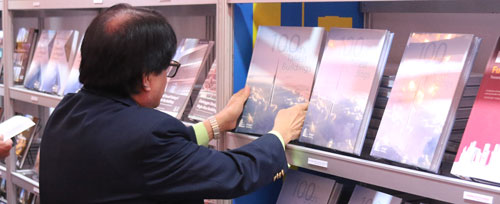 This year, the Conference coincided with the launch of 100 of the World’s Tallest Buildings, a continuation of the highly acclaimed “100 Tallest” series produced by the CTBUH. This book, available for purchase at the CTBUH Exhibition Suite, examines the projected 100 tallest buildings in the world in a collection of highly informative and visually engaging profiles. Detailed descriptions of these projects are provided, along with precise height data and building metrics.
This year, the Conference coincided with the launch of 100 of the World’s Tallest Buildings, a continuation of the highly acclaimed “100 Tallest” series produced by the CTBUH. This book, available for purchase at the CTBUH Exhibition Suite, examines the projected 100 tallest buildings in the world in a collection of highly informative and visually engaging profiles. Detailed descriptions of these projects are provided, along with precise height data and building metrics.
Tall Building Survey Engages Delegates
During each scheduled break between sessions, delegates were asked a series of thought-provoking questions related to the impact that tall buildings have on their immediate surroundings from an economic, social, and environmental perspective. This survey, sponsored by Arcadis, was formulated as a way to highlight important topics that could lead to a dedicated research effort helping us better understand critical aspects of urbanization and tall buildings around the world, similar to the Arcadis-developed Sustainable Cities Index, which ranks and assesses cities across a range of telling indicators.
Plenary Three: The Emergent Future of Tall
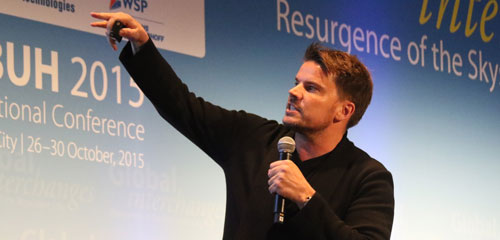 Once again, the ballroom flywalls were opened and the entire Conference attendance gathered in unity for the Closing Plenary, Towards the Future. CTBUH Vice Chairman Timothy Johnson had the pleasure of introducing the three distinguished speakers, who each imparted their projects and philosophies that will come to define the future of tall buildings. Bjarke Ingels, Founding Partner, Bjarke Ingels Group, opened with a passionate call for a new generation of responsive design for tall buildings and architecture as a whole, accounting for cultural heritage, what he calls “social infrastructure,” and the critical merger of public and private urban space. Showcasing an impressive roster of projects in production around the world, Ingels backed up these imperatives with many of his firm’s recent pursuits, including the “courtscraper” known as Via 57 West in New York. The audience was also treated to a video depicting the vision for a 12-mile protective barrier that takes lessons learned from the Highline by incorporating myriad social and commercial spaces. Ingels noted, “Architecture and engineering is in a way the art and science of turning fiction into fact. We take something that is a pure figment of our imagination then through hard work and years of permits and tests it become concrete reality.”
Once again, the ballroom flywalls were opened and the entire Conference attendance gathered in unity for the Closing Plenary, Towards the Future. CTBUH Vice Chairman Timothy Johnson had the pleasure of introducing the three distinguished speakers, who each imparted their projects and philosophies that will come to define the future of tall buildings. Bjarke Ingels, Founding Partner, Bjarke Ingels Group, opened with a passionate call for a new generation of responsive design for tall buildings and architecture as a whole, accounting for cultural heritage, what he calls “social infrastructure,” and the critical merger of public and private urban space. Showcasing an impressive roster of projects in production around the world, Ingels backed up these imperatives with many of his firm’s recent pursuits, including the “courtscraper” known as Via 57 West in New York. The audience was also treated to a video depicting the vision for a 12-mile protective barrier that takes lessons learned from the Highline by incorporating myriad social and commercial spaces. Ingels noted, “Architecture and engineering is in a way the art and science of turning fiction into fact. We take something that is a pure figment of our imagination then through hard work and years of permits and tests it become concrete reality.”
Similar notions of social vibrancy were echoed by Kai Li, Vice President, Zhongtian Group, who disclosed how the Guizhou Culture Plaza Tower would become a central component of Guiyang, China’s emergence as a third-tier city built for people. Li welcomed SOM Design Director Collin Koop to the stage, who explained that the tower’s site along the nearby river was considered a critical civic axis of activity. As such, public access points to the tower at various levels became a primary driver of its design. Koop rationalized the tower’s unique structural super frame system, which resulted in not only an interesting design, but incorporates a silhouette that directly relates to the city of Guiyang.
The final presentation was given by Ming (Thomas) Tsang, CEO, Ping An Life Insurance Company and Yongmin (Stephen) Yuan, General Manager, Risk Management, Ping An Property & Casualty Insurance Company. The presentation chronicled the development history of the Ping An Finance Center, touching on its various iterations in the design stage and the unique engineering aspects of its final incarnation. Yuan then delved into the “bread and butter” of the Ping An Property & Casualty Insurance Company, summarizing the complexities of risk analysis and insurance policies for tall buildings, which must consider copious variables like site dimensions, the likelihood of a natural disaster, and the type of construction activities required for development. In the case of Ping An Tower, an innovative risk control plan was developed to ensure the safety of workers and reduce the overall risk in developing the project.
2015 Conference Close / 2016 Conference Launch
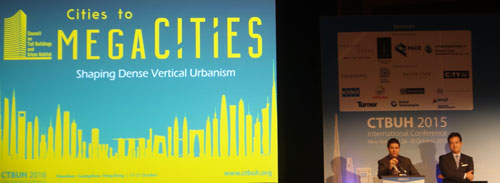 Although a day of Technical Tours and two days of Regional Tours are to follow, the time came for the main program of the CTBUH 2015 Conference to officially close. CTBUH Executive Director Antony Wood took the stage once again to thank all for attending, expressing added appreciation for the four Diamond Sponsors of the Conference: Hudson Yards, Jeddah Economic Company, PACE Development, and Zhongtian Group.
Although a day of Technical Tours and two days of Regional Tours are to follow, the time came for the main program of the CTBUH 2015 Conference to officially close. CTBUH Executive Director Antony Wood took the stage once again to thank all for attending, expressing added appreciation for the four Diamond Sponsors of the Conference: Hudson Yards, Jeddah Economic Company, PACE Development, and Zhongtian Group.
With the closing of the 2015 event, so came the launch of the 2016 Conference entitled Cities to Megacities: Shaping Dense Vertical Urbanism. In an unprecedented first for a CTBUH Conference, the event will take place progressively across three cities, starting in Shenzhen, before moving on to explore the industrial powerhouse, Guangzhou, then the premier urban laboratory that is Hong Kong. In addition to absorbing the very latest in best practice developments in both skyscraper and urban design form around the world, this conference will directly embrace numerous tall buildings in the region that have become iconic in their own right, through technical tours and social networking events. So get involved now and join us in the Pearl River Delta “mega-region” for an investigation like no other into the true facets of urbanization and vertical growth!
Hudson Yards Reception Offers a Memorable Closing Night
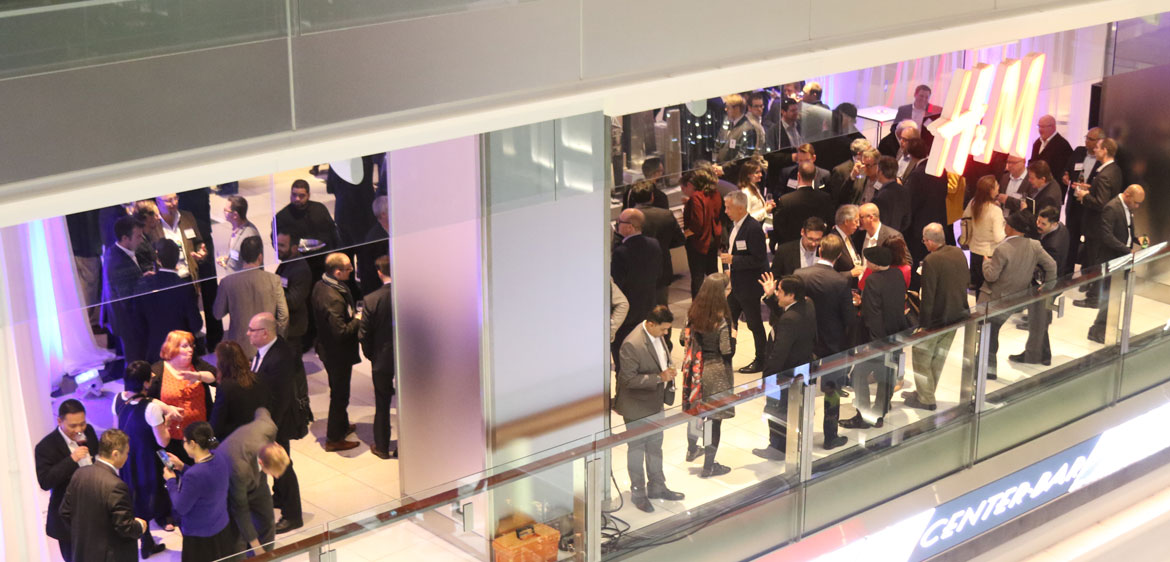
Two days of examination and captivation then gave way to the cathartic powers of friendly conversation and well-deserved sustenance at the Networking Reception in the evening. The event, which was hosted and sponsored by Hudson Yards, offered great views of Columbus Circle at the southwest corner of Central Park from the vantage point of the Time Warner Center, a two-tower high-rise complex that integrates a large commercial center at its base. With drink in hand and a fresh reservoir of insights to ponder, one could not help but eagerly await the next three days, which would give delegates a chance to explore numerous tall buildings through Technical Tours in New York and Regional Tours in cities across the North American region. More on that tomorrow…
Scenes From the Day

